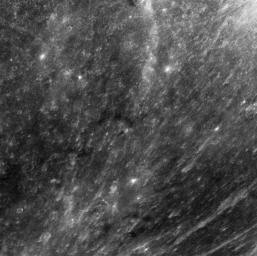
|
The Amazing Rays
- Click the image above for a larger view
- Full-Res JPEG (1024 x 1020) (161.8 kB)
- Full-Res TIFF (1024 x 1020) (1.0 MB)
Caption:
Even when they're not in the picture, craters Debussy and Berkel still leave their mark. The rays of Debussy, outside of the image to the southwest, and Berkel to the northeast, cross the scene.
This image was acquired as a high-resolution targeted color observation. Targeted color observations are images of a small area on Mercury's surface at resolutions higher than the 1-kilometer/pixel 8-color base map. During MESSENGER's one-year primary mission, hundreds of targeted color observations were obtained. During MESSENGER's extended mission, high-resolution targeted color observations are more rare, as the 3-color base map covered Mercury's northern hemisphere with the highest-resolution color images that are possible.
Date acquired:
March 03, 2013
Image Mission Elapsed Time (MET):
4620855
Image ID:
3622493
Instrument:
Wide Angle Camera (WAC) of the Mercury Dual Imaging System (MDIS)
WAC filter:
7 (748 nanometers)
Center Latitude:
-18.53°
Center Longitude:
19.80° E
Resolution:
449 meters/pixel
Scale:
This scene is approximately 570 km (354 mi.) across
Incidence Angle:
31.7°
Emission Angle:
51.4°
Phase Angle:
28.0°
North is up in this image.
Background Info:
The MESSENGER spacecraft is the first ever to orbit the planet Mercury, and the spacecraft's seven scientific instruments and radio science investigation are unraveling the history and evolution of the Solar System's innermost planet. MESSENGER acquired over 150,000 images and extensive other data sets. MESSENGER is capable of continuing orbital operations until early 2015.
For information regarding the use of images, see the MESSENGER image use policy .
Cataloging Keywords:
| Name | Value | Additional Values |
|---|---|---|
| Target | Mercury | |
| System | ||
| Target Type | Planet | |
| Mission | MESSENGER | |
| Instrument Host | MESSENGER | |
| Host Type | Orbiter | |
| Instrument | Mercury Dual Imaging System (MDIS) | |
| Detector | Wide Angle Camera (WAC) | |
| Extra Keywords | Crater, Grayscale, Map, Radio | |
| Acquisition Date | ||
| Release Date | 2013-03-26 | |
| Date in Caption | 2013-03-03 | |
| Image Credit | NASA/Johns Hopkins University Applied Physics Laboratory/Carnegie Institution of Washington | |
| Source | photojournal.jpl.nasa.gov/catalog/PIA16904 | |
| Identifier | PIA16904 | |
